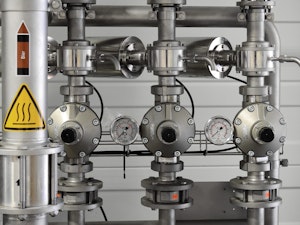There are many different types of maintenance strategies that might be useful for your business. In this article, we’ll specifically be focusing on reactive maintenance, covering subcategories of reactive maintenance, benefits, disadvantages, cost, examples, and more.
What is Reactive Maintenance?
Reactive maintenance, unlike preventive maintenance, involves responding to equipment malfunctions or breakdowns after they occur in order to restore the asset to normal operating condition. This differs from the proactive maintenance strategy of aiming to anticipate equipment issues ahead of time, and taking steps to prevent them from occurring.
Reactive maintenance can be a beneficial plan for your business from a financial perspective, as it takes less time and and money to have equipment repaired when needed, rather than performing routine maintenance to prevent the breakdown from occurring. That said, it’s recommended that reactive maintenance isn’t your sole maintenance strategy in place for equipment repairs, as it’s often not sustainable in the long run for valuable machinery. For essential assets, it’s a good idea to implement a mix of routine, preventive, and reactive maintenance strategies.
Though the idea of “reactive maintenance” sounds relatively straightforward, there are a few nuances among specific types of reactive maintenance. Let’s examine a few of those in depth.
Types of reactive maintenance
Reactive maintenance is an umbrella term for the following types of maintenance, all of which are responsive strategies to solve a preexisting mechanical issue:
Breakdown maintenance
Breakdown maintenance refers to action taken on a piece of equipment that won’t start or operate whatsoever. The machinery is completely broken, and may require extensive repairs to run again (or may need to be replaced entirely).
In most cases, breakdown maintenance is an unplanned event, and the repairs are urgently requested in order to resume normal business operations. In the event of any type of stall or delay, the time in between can result in downtime, which will ultimately affect the bottom line of a business. If at all possible, it’s always extremely helpful to have some kind of backup plan in place should an essential piece of equipment fail. This will serve to minimize losses.
A bit more unusual are planned breakdowns, for which a business can properly prepare for and work around the maintenance of an asset. Run-to-fail (or RTF) triggers are an integral part of planned breakdowns, as they enable equipment to run until they can no longer function, giving the business enough time to request repairs. Such planning can ultimately reduce the cost of the maintenance performed.
Run-to-failure maintenance
Run-to-failure maintenance is deliberately allowing a machine to run until it breaks down. After the failure, reactive maintenance is performed—no prior or preventive maintenance is performed on the machine in advance.
The difference between run-to-fail and breakdown maintenance is that run-to-fail is always a deliberate decision (i.e. planned), and there is some type of plan in place to repair the item without interrupting production. In addition, the equipment that is allowed to break down does not pose a health or safety risk to operating personnel.
A very simple example of run-to-fail maintenance is allowing a light bulb to burn out before worrying about replacing it, but can also refer to machinery that simply stops running on its own after a while, as part of a normal operational process. Rather than stopping everything to perform preventive maintenance (and absorbing associated costs), it makes more sense to simply wait for the machine to break down on its own before performing maintenance.
Corrective maintenance
Corrective maintenance any type of action that targets and repairs a system malfunction so that equipment can be restored to proper working order. One plus of corrective maintenance is that the defect may be caught or noticed before it causes a significant problem, or results in a total equipment breakdown.
The important thing to remember about corrective maintenance is that it does not require the repair of a totally-busted asset. Rather, corrective maintenance is performed to correct a defect, or a potential problem area, in equipment that is still running. This gives the business more time to respond to issues, and even mimics preventive maintenance by allowing for the opportunity to correct problems before they escalate.
Corrective maintenance is often performed on faulty parts that are discovered while other repairs are being made to the same machine. For instance, if you’re installing new carpeting in your office and discover mold growth beneath the old carpet, you would then take steps to understand and correct the conditions of such growth.
Emergency maintenance
Emergency maintenance requires a last-minute response to the sudden breakdown of an asset. However, emergency maintenance entails some type of threat to health and safety (e.g. safety locks fail on a machine with hazardous moving parts).
Unlike breakdown maintenance, emergency maintenance is never planned, though businesses can have plans in place so that personnel is prepared in the event of an emergency. In general, it’s recommended that all emergency phone numbers for dealing with incidences of emergency maintenance are listed in a high-traffic area, and that there is an effective evacuation plan in place, should the circumstance call for it.
The best way to prevent emergency maintenance is by adhering to planned and preventive maintenance routines, which help to identify issues that could escalate to emergency situations if not addressed.
Benefits of reactive maintenance
As with most maintenance strategies, there are pros and cons to the reactive approach. Here are three benefits of reactive maintenance:
1. Lower upfront costs
If you don’t typically invest in any type of preventive maintenance strategy for your assets, it’s undeniable that you’ll save some money upfront that you would have spent on preventive maintenance actions and labor costs. It’s worth mentioning, though, that running a business solely using reactive maintenance, without any type of preventive maintenance strategy in place, can be extremely costly for your business in the long run.
2. Fewer staff members needed
If you’re primarily concerned about responding to accidents and breakdowns when they occur, this also means that you’ll likely have a smaller group of staff to run and manage equipment. Preventive maintenance typically requires at least one or two employees who does weekly and monthly inspections to spot potential problems in advance, which results in paying extra salaries.
3. No planning time necessary
Preventive maintenance requires planning, and often allocates equipment downtime for inspections, part replacements, etc. Reactive maintenance means no planning, no scheduling, and no equipment downtime up front. Do plan on unexpected downtime should equipment fail in the future, though.
Disadvantages of reactive maintenance
Reactive maintenance is most often associated with serious business disadvantages, and a maintenance strategy that relies solely upon reactive actions is not recommended. Here are five reasons why:
1. Unpredictable budget
Unfortunately, performing reactive maintenance can be a very pricey ordeal, especially if equipment needs to be fixed urgently (which if often the case)—additional costs may be tacked on for hurried turnaround time requests.
Moreover, if the equipment in need of repairs is very old, outdated, or simply requires more money to fix than to replace, prepare to spend an unpredictable amount of money on brand new machinery. Due to the likelihood of urgency, you may also end up spending more than you would if you’d had more time to compare costs from different vendors.
2. Unexpected equipment downtime
Perhaps the biggest disadvantage to reactive maintenance is equipment downtime, which could cause business closures or a production halt for a day, or several days. This is especially detrimental for manufacturing industries, where downtime can lead to layoffs, or even shutting whole plants down for an undetermined amount of time. Both of these will greatly impact your business’s bottom line.
3. Overtime for relevant employees
On top of the initial hemorrhaging of money that reactive maintenance typically requires, you may also have to pay overtime for employees who are responsible for the equipment in question. For instance, if there are one or two staff members who run the failed machine more frequently than anyone else, you may find you need their extensive knowledge about the broken equipment as you consider repairs.
4. Shorter equipment life expectancy
If your only maintenance strategy is to do just enough to keep a valuable piece of equipment up and running, it’ll deteriorate that much faster—meaning you’ll have to replace the equipment faster than you would if you took basic preventive maintenance steps.
5. Higher energy costs
Typically, machines and equipment that aren’t properly maintained use more energy to run than well-maintained equipment does. Faulty appliances often mean much larger surges of electricity, which (depending on the equipment in question) can further damage the machine, and possibly result in a higher electric bill.
Avoiding too much reactive maintenance
As stated earlier, it’s not a good idea to rely solely on reactive maintenance as a way of caring for your assets. Ideally, your business should incorporate a mix of preventive and reactive maintenance techniques. This may also be the most cost-effective solution.
For higher-value equipment and large machinery, it’s preferable that you perform routine maintenance and inspections so as to prevent costly breakdown repairs, or equipment replacements. For lower-value items, such as small appliances (e.g. exhaust fans, low-temperature water heaters), reactive maintenance is probably a worthwhile strategy.
Remember: if the risk of an asset’s breakdown is more costly than prevention, always employ preventive maintenance. Don’t wait for failure to take action.
How much does reactive maintenance cost to implement?
The costs associated with reactive maintenance vary greatly, depending on the scope of repairs needed and the value of the item in question.
In general, it’s a pretty safe statement that reactive maintenance is a cost-effective approach upfront, but ends up becoming more costly and more trouble than it’s worth—for example, when equipment breaks down in the midst of peak production periods, and when a business needs to seek outside assistance for extensive repairs. Both of these become costly, time-consuming processes that perhaps were never factored into a budget, or were never factored into production planning.
If you’re interested in saving your business as much money as possible, implement a combination of preventive and reactive maintenance for cost-effective, stress-free operations.
How should reactive maintenance fit into a maintenance program?
Every business has a unique way of maintenance program—there is no “one size fits all.” If you rely on some type of reactive maintenance for one or more assets of your business, or believe that some reactive maintenance strategies may be right for you, start by calculating the value of your assets against your budget for repairs, maintenance, etc. For the costly equipment you’ve listed, research best maintenance strategies, and weigh the pros and cons of preventive maintenance vs. reactive maintenance as a strategy for each.
For the most accurate financial projections and calculations, use a work order software or app to view the return on investment (ROI) you’re accruing by implementing preventive maintenance on one or more of your assets. These programs slash the time you’d spend tracking funds manually in half, and many of these types of software are very affordable.
In addition to helping you track your ROI and determining your maintenance budget, work order software programs also help with organization, and allow you to create and submit digital work order forms in one streamlined system. Several of these programs even include templates and checklists, so that employees can fill out such forms quickly, and on their own.
Examples of reactive maintenance
Now that you know more about reactive maintenance, let’s review a few circumstances that would qualify:
1. A school’s HVAC unit breaks down unexpectedly.
A maintenance technician would be alerted and would have to diagnose the cause of the failure. Depending on what caused the failure, the repair costs can vary greatly.
2. A bearing is overheating inside a machine
Overheating is generally the cause of improper lubrication. The fix is simple and specific, lubricate the bearing.
3. A forklift is not raising or lowering properly.
This may be an indication of hydraulic problems. In this case, the leaking cylinder would be repaired, and any defective forklift parts would be replaced (i.e. oil filter, oil seals).
4. A treadmill at the gym is malfunctioning.
If the problem is not solvable by referring to the equipment’s manufacturer recommendations , a technician (either on-site or independent) would need to be called promptly to restore the machine to safe and standard working condition.
5. A restaurant’s dishwasher isn’t properly cleaning dishware and utensils.
In this situation, a local repair company should come and inspect the dishwasher as soon as possible.
Reactive maintenance can be an effective part of your maintenance strategy for businesses across industries. However, it is recommended that you don’t rely solely on reactive maintenance as a solution for all asset breakdowns. Analyze your budget, take note of your most valuable machinery, and determine where reactive maintenance might be the right choice for you!
Found this post helpful? Share it:




